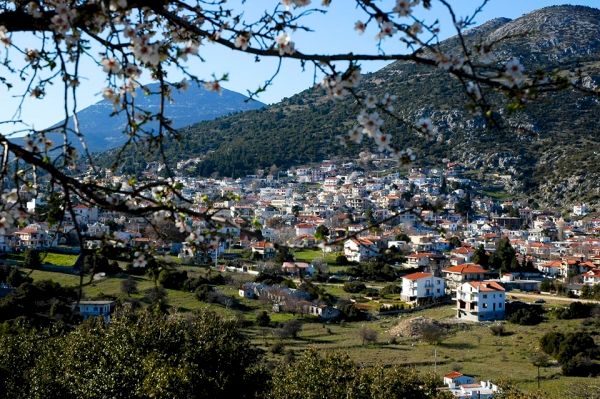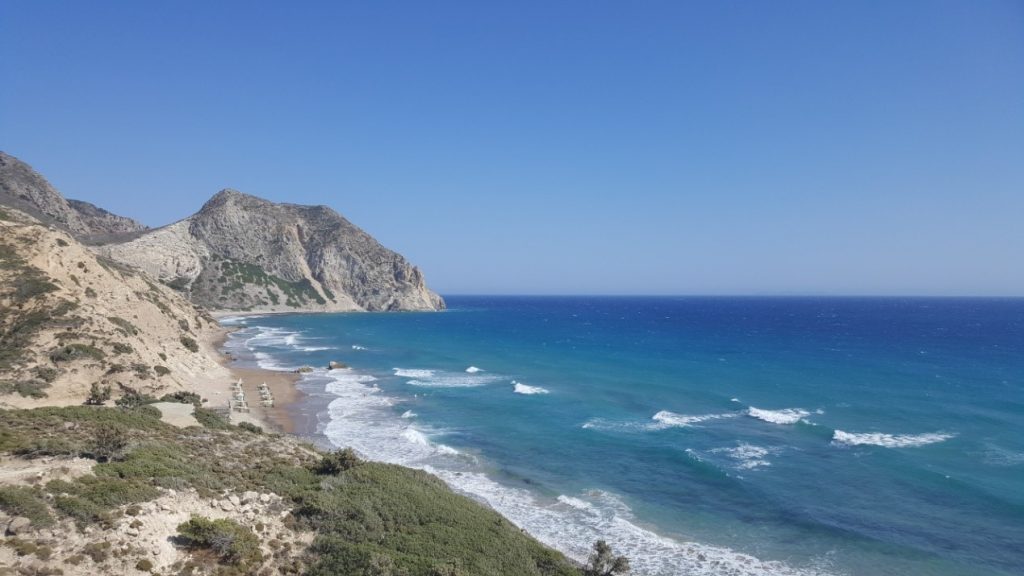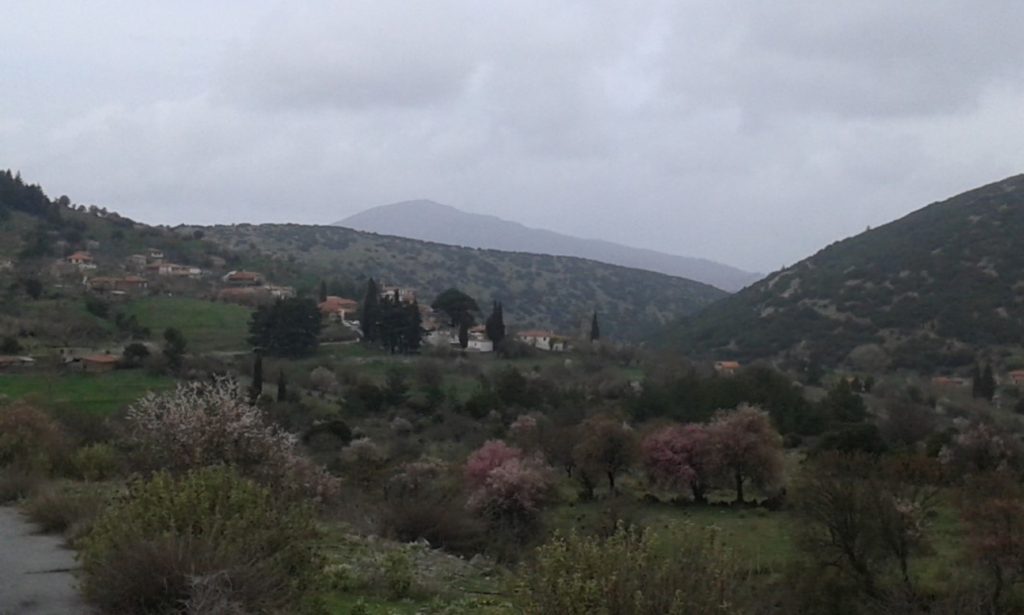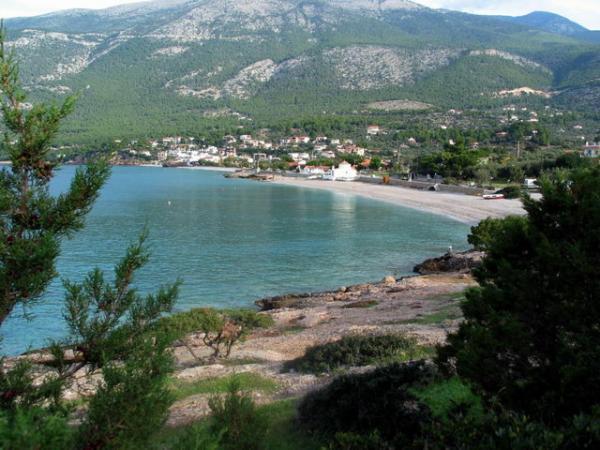Nicosia - Nicosia, Cyprus passage in Occupied Nicosia
OR Nicosia It is the capital of Cyprus. The Franks told Nicosia and later the Venetians, Nicosia. He was one of the ancient cities – kingdoms of the island, or Ancient Ledra (Ledra). The name of Nicosia won the first Christian times probably due to the limestone, ie "white"soil.
It became the capital of the island in the Byzantine era, when the residents fled coastal areas to guard against raids.
Located in the center of the island, the plain of Mesaorias, between the Troodos Mountains and Pentadaktylos.
NICOSIA – SIGHTS
- ARCHAEOLOGICAL MUSEUM or MUSEUM OF CYPRUS
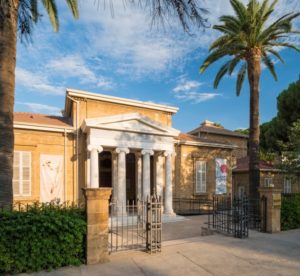
features 14 Halls with archaeological finds from the Prehistoric Period to the Early Christian Era.
room I : Neolithic Period (8.500 – 5.200 B.C.) Chalcolithic Period (3.900-2.400 B.C.). Stone and bronze objects from 1s islanders, probably from Syria and Anatolia.
hall II & III : early & Middle Bronze Age (2.300 – 1.600 B.C.). Ceramic vessels erythrostilvotis pottery figurines and religious symbols.
hall III : Late Bronze Age (1.600 -1050 BC). Golden jewelry, bronze and ceramic figurines, Mycenaean cups, amphorae.
hall IV : Archaic Sanctuary of Agia Irini. About 2000 clay figurines and statues mainly male forms, from excavations in the Sanctuary.
room V & VI hall : Hellenistic and Roman Period (310 BC-330 AD). It boasts the famous marble statue of naked Venus from Soloi (1th century. B.C.) and the bronze statue Roman Emperor Severus Septimiou from Kythrea (2The half of 1th century. B.C.)
VII hall : Early Bronze Age – Early Christian Period. Stands the bronze statue of horned God Engomi.
room VIII : Reconstruction of Ancient Tombs (4or millennium-4The century. B.C.)
room IX : Tombstones and clay sarcophagi of limestone.
room X : Evolution of Scripture in Cyprus (15th -11th century. B.C.). It boasts the Cypro-Minoan script which has not yet been deciphered.
room XI : Ancient necropolis of Salamis (8th -authorities 7th century. B.C.). Finds from the royal tombs as the last King of Salamis, Nikokreonta.
room XII : Periodic reports
room XIII : Statues from the Roman Gymnasium Salamis. Stands the marble statue of Apollo Trader (2th century. A.D.).
XIV hall : Early Bronze Age – Roman Period. Topics with clay figurines of Cyprus.
Address : Museum 1, Nicosia, tel.: +357 22 865 854, +357 22 865 888, www.mcw.gov.cy
- MAKEDONITISSAS or TYMVOS OF MILITARY CEMETERY MAKEDONITISSAS
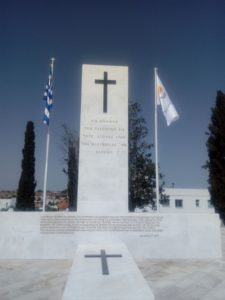
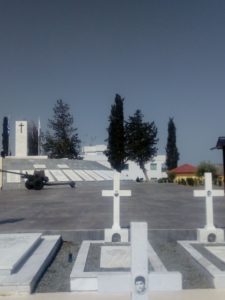
THE Tomb of Makedonitissas it's the Military Cemetery of fallen the struggles against the Turks (1964 and 1974). Tomb buried in the wreckage of the aircraft type 'Noratlas"Which was shot down, at 22 July 1974, by friendly fire. moved the 1or Commando Squadron from Greece to Cyprus, for the defense of the island. All occupants, except Commando Thanasis Zafiriou, jumped into the void, killed. Address : heroes, area Makedonitissa, Engomi (approximately 35′ by bus from the center of Nicosia).
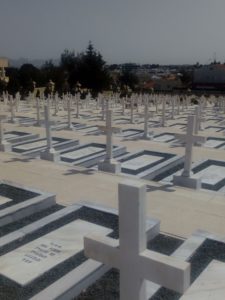
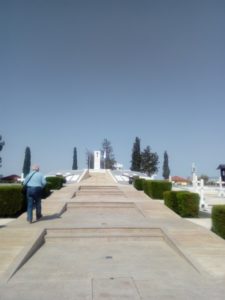
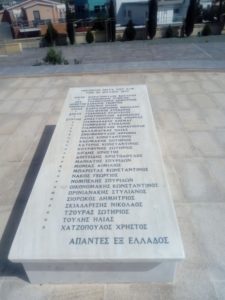
- imprisoned Graves
The "Imprisoned Graves' words Cemetery of Fighters of EOKA located in Nicosia Central Prison. EOKA – National Organization of Cypriot Fighters was a nationalist – guerrilla organization that acted years 1955-1959. The purpose of the exemptions from British Colonialism and the Union of Cyprus with Greece. Leader of EOKA was Georgios Grivas Digenis or (1897 – 1974).
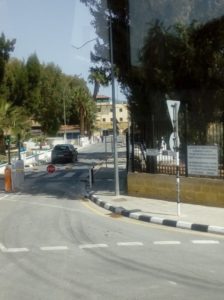
ENTRANCE CENTRAL PRISON
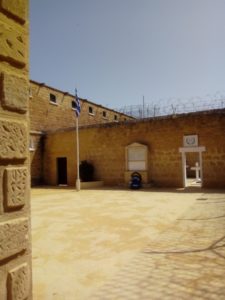
"Imprisoned Graves'
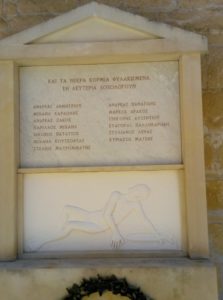
THE GRAVES OF 9 APAGCHONISMENON
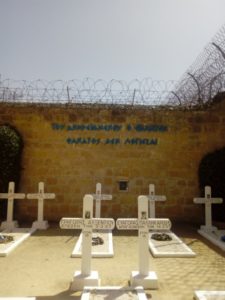
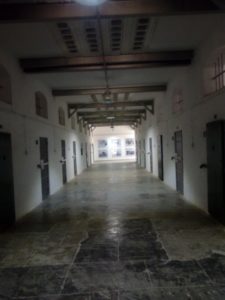
PRISONS – CELLS
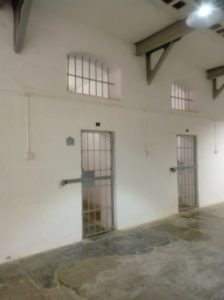
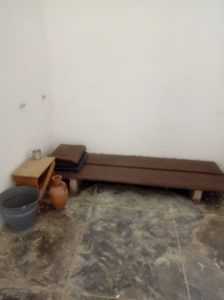
INTERIOR Kelly
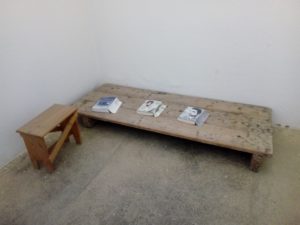
KELI ISOLATION
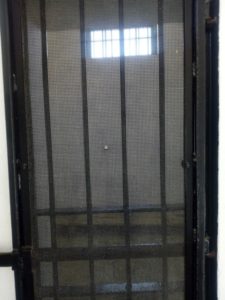
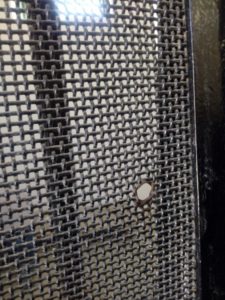
KELI ISOLATION- HOLE FROM WHICH passed cigarettes
hangings
THE John Harding (1896 -1989) He was a British military officer and Governor of Cyprus, from the 3 October 1955, the time EOKA acted. The Harding has implemented very strict security measures such as curfews, closing schools, creating camps, increased detention time prisoners and suspects without trial, death penalty for possession and use of firearms. Due to the harsh criticism internationally accepted, mainly for the application of the death penalty, He was forced to resign in 1957.
At 7 May decided the death penalty in M. Karaoli and Andreas Demetriou and 10 May 1956 hanged. The Karaolis was convicted of the murder of a policeman and Demetrius in 24 November 1955 had shot, not kill, an Englishman who lived in Famagusta. In total 9 agonists EOKA hanged between 1956-1957. were the : Michael Karaolis and Andreas Demetriou (10-5-1956), Andreas Zakos, James Patatsos and Charilaos Michael (9-8-1956), Michael Koutsoftas, Stelios Mavrommatis and Andreas Panagides (21-9-1956) and Evagoras Pallikaride (14-3-1957). Among the graves of 9 apanchonismenon located and Afxentiou, of 2th the hierarchy of the organization. Afxentiou burned alive by the British, inside the hideout, the battle that took place near Machairas monastery (3-3-1957). The burial of fighters decided to place within the Nicosia Central Prison, to avoid any violent protests and incidents.
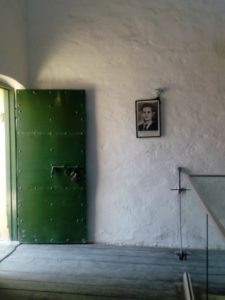
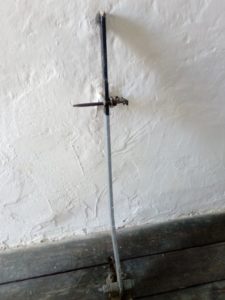
HALL hangings
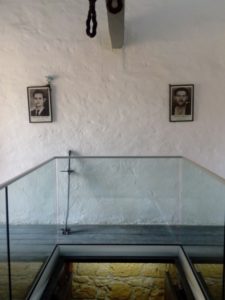
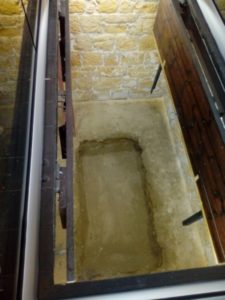
Hatches IN WHICH THE fall APAGCHONISMENOI
In the area of "imprisoned Graves"Operates a shop with books on the EOKA action, biographies of fighters etc..
- VENETIAN WALLS – OLD NICOSIA
Nicosia is occupied by Franks, Venetians, Ottomans and British. The first walls were built by the Franks (14th c.) and were larger, in length, from the later Venetian. The circular walls of Old Nicosia were built by the Venetians between 1567-1570 to prevent the Ottomans to invade the city. The perimeter of the walls are 11 Bastion and heart-shaped 3 gates. A portion of the Venetian Walls and 5 from the 11 Bastion in the occupied Nicosia. The 3 Gates is Famagusta gate or Door Giuliani, or Paphos gate or Porta San Domenico (the UN department) and the Kyrenia gate or Port of proveditor.
From the Bastion you can see is the Podocatro Bastion (next to the Freedom Monument and the ancient aqueduct), The Bastion Costanza (Bayraktar Mosque), The D’Avila Bastion (at the town hall) and Bastion Tripoli (in parking).
Perimeter is the trench walls, about width 80 m. where you can walk, to ride or watch a thematic exhibition.
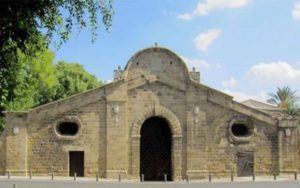
Famagusta Gate was the most impressive and led to the port of Famagusta. Originally known as Porta Giuliani in honor of Giulio Savorgnano, the engineer who built the Venetian Walls.
The Gate is now Cultural Center of D.. Nicosia. in Trench Famagusta Gate every year Festival "Medieval Nicosia" which includes outdoor activities.
- PARK OF MEMORY or Statue of Liberty or MONUMENT EOKA STRUGGLE
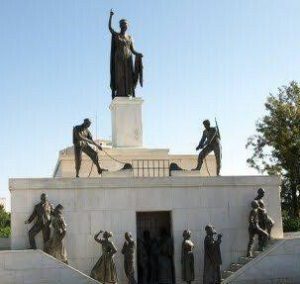
The Statue of Liberty placed the 1973 in Memory of the EOKA Fallen (1955-59). You will see 16 bronze statues that come out of the darkness of prison outside light to Freedom. The inauguration of the monument planned for summer 1974 but the invasion of the Turks prevented unveiled. Address : Adamantios Korai, Constantine Paleologos & Nikiforos Fokas, in Podocatro Bastion
- ANCIENT AQUEDUCT or AQUEDUCT SILICHTAR (18th c.)
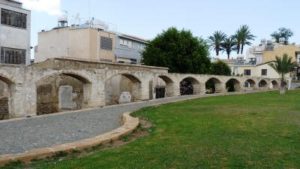
The ancient Aqueduct It was part of the old Nicosia Water Supply System. It is known as aqueduct Silichtar, by the then Ottoman Governor. It is a stone arched construction near Freedom monument and the Podocatro Bastion
- OLD NICOSIA
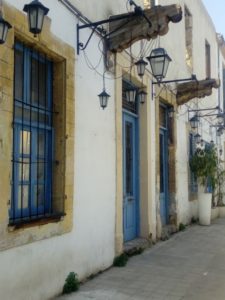
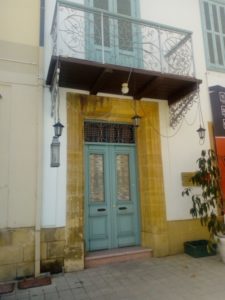
Characteristics houses the Old Nicosia Cypriot urban architecture
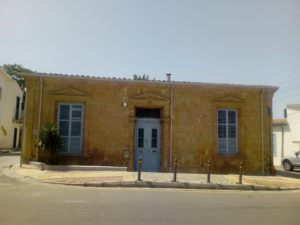
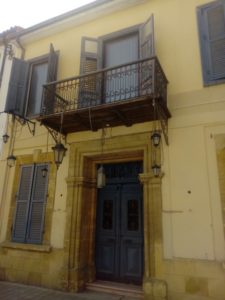
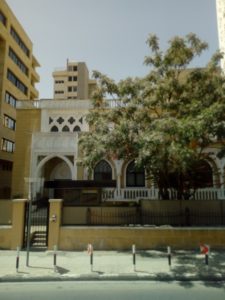
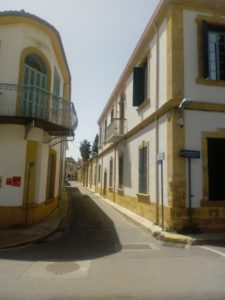
- ARCHDIOCESE – FOUNDATION Makarios OF C
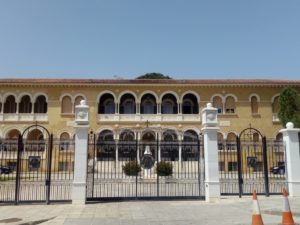
Located in Old Nicosia, Square Martyrs Cyprian. It is the official residence of the Archbishop of Cyprus and is closed to the public.
- MUSEUM OF FOLK ART OF CYPRUS
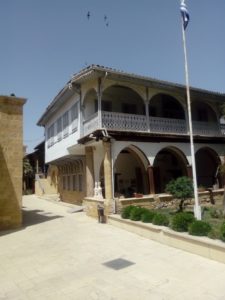
Founded in 1937 Housed in a building 15th century. within the Archdiocese. You will see more than 5000 objects like textiles, lace, embroidery, folk art, metalware, ceramics. It operates a shop with books, embroidery, bookmarks etc.. Address : Martyrs Square Kyprianou.
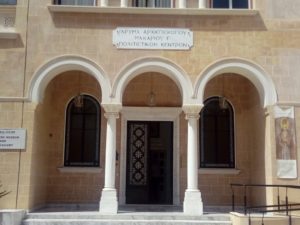
Foundation Archbishop Makarios III
- CATHEDRAL CHURCH OF ST JOHN
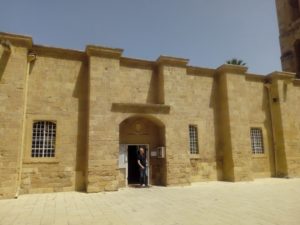
Located on the same site as the Archbishop Makarios III Foundation, next to the Archbishopric. It is dedicated to St. John the Theologian is celebrated on 8 May the feast of St. John 26 September, in metastasis. The Cathedral of St. John founded in 30-4- 1662 the Archbishop of Cyprus Nikiforos (1641 – 1674) in place of the older Catholic Benedictine Monastery. She is a single, vaulted, built of limestone. The splint covered with cross vault was built around the 1779 the Archbishop of Cyprus Chrysanthos (1767-1810). Inside the Temple, images of St. John the Baptist (1797) and Archangel Michael (1798) attributed to the great painter John Cornaro, who lived on the island.
- Byzantine Museum & GALLERY
Located on site Foundation Archbishop Makarios III and next to Church of St. John. You will see the largest collection of pictures from Cyprus 5The -19The c., Wall paintings, parts mosaics 6th century. the arch of the Church of Our Lady in Kanakarias Lythragkomi Famagusta, sacred vessels, vestments, etc. (www.makariosfoundation.org.cy).
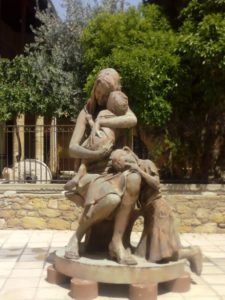
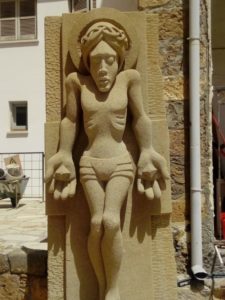
STATUES ON THE ENTRY OF BYZANTINE MUSEUM
- Pancyprian Gymnasium - MUSEUM
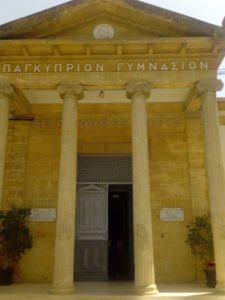

launched in 1753 as "Ellinomousion " and it is the oldest school in Cyprus. The 1812 The Cyprus Archbishop Cyprian created a four-grade Gymnasium, the "Greek School Nicosia». The 1893 the Archbishop of Cyprus Sophronius III turned it into six classes and 1896 renamed Cyprus Gymnasium. Located opposite the Archdiocese building. In the school entrance installed 2 marble inscriptions found :
«Since High School graduated 1915 Chief of the Cyprus Liberation Struggle 1955-1959, General Georgios Grivas Digenis" and "Since High School graduated 1836 Archbishop Makarios III, 1th President of the Republic».
At 13 Of March 1949 founded Severeios Library which belongs to Pancyprian Gymnasium. The Museum of the Pancyprian Gymnasium includes : European School History, Archaeological and Numismatic Collection, Collections of Old Maps and Weapons, Collection of Natural History and Gallery with works by Cypriot artists, graduate school. address Museum : Ag. John and Theseus, Archbishop Kyprianou Square, old Nicosia
POPULAR NEIGHBORHOOD NICOSIA
It is the pedestrian area of Old Nicosia, "Inside the walls" and the most touristic. Narrow alleys, traditional houses, restaurants and souvenir shops, clothes, embroidery etc..
Access : from Piazza NO to the streets Aristokyprou, Praxander, Prasikratous, Fillokyprou, Liberty Square to the Ledra Street.
- HOUSE Hadjigeorgakis HORNS – MUSEUM
The residence of Dragoman Hadjigeorgakis Kornesios (18th c.).
The dragoman Dragoman or was the interpreter between the Christian population and the Ottoman governor. The mansion, a characteristic example of Cypriot urban architecture 18th c., the 1988 He got the Europa Nostra prize.
Address : Patriarch Gregory 29, old Nicosia
- LEVENTEIOS GALLERY
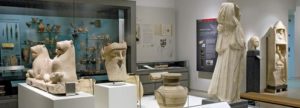
Public gallery with collections of Cypriot businessman and collector Anastasios G.. Leventis (1902-1978). The Gallery houses permanently 3 collections, the Collection Paris, with European art (17th -20th ), the Greek Collection, from the personal collection of the collector (19th -20th ) and Cyprus Collection, by Cypriot artists (authorities 20th -1930). Address : Anastasios G.. Leventis 5, old Nicosia www.leventisgallery.org
- Liberty square
Old Nicosia joins the modern city. The reconstruction of the square was awarded the prestigious architectural firm of Zaha Hadid and comprises a striking bridge over the square, underground parking and shops.
- TOWER 25 ή WHITE WALLS
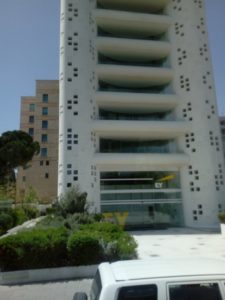
The tower 25 or White Walls or Jean Nouvel Tower 25, by renowned architect Jean Nouvel, Located in the center of Nicosia. height 67 m. and with 16 floors are 4The tallest building in Cyprus. The small windows size 40CH40 cm apart from decorative role and provide light inside. The first 6 floors are offices and other apartments, the top floor have pool. In Nicosia is under construction many tall buildings like 360 Nicosia (34 storey), the LABS Tower, the Metropolitan etc. Address : Stassinos, Liberty square (www.jeannouvel.com)
- CHURCH OF VIRGIN CHRYSALINIOTISSAS
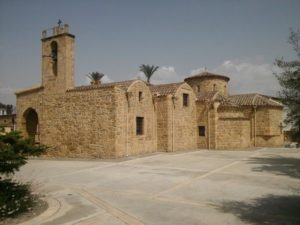
Considered the oldest Byzantine church of Old Nicosia. built in 1450 the wife of the King of Cyprus, John II of Lusignan, Helen Palaiologina (1428 – 1458). The church was reconstructed around 1735, during the Ottoman, the standards of the original Byzantine. Inside stand out the temple's image Lady Chrysaliniotissa, which is right by the Beautiful Gate and the image of Christ on the left and the twin portable image Lady Lover and Misitikis wherein Notre looking in different directions. Near the Church of Our Lady Chrysaliniotissa lies the Church of St. Cassian. Address : Chrysospiliotissis 13 (open daily 6:30 a.m. -2:30 p.m.)
- CHURCH OF VIRGIN FANEROMENIS
built in 1872-3 the old medieval monastery site and is of type basilica with a dome. inside, the image of Faneromeni (14th ) Keep within the sanctuary while the iconostasis will see copy (1924), work of Cypriot painter, Adamantios Diamantis. In the courtyard there is a marble Mausoleum (1930) the Martyrs relics were massacred by the Turks in 9 July 1821, as Archbishop of Cyprus Kyprianou. Address : Revealed, Muses and Mary senators, old Nicosia
- MOSQUE MOSQUE OF Omeriye or EMERKES – BATH Omeriye
The church of the medieval monastery of St. Mary of the Augustinians who became the 1570 a mosque. The Steam Omeriye (Omery in Bath baths), Ottoman baths next to the mosque is private and you can go for a traditional hammam (www.hamamomerye.com) Address : Trikoupi 8, Tyllirias square, near Archdiocese
- MOSQUE Bairaktaris
The mosque is dedicated to the Ottoman standard bearer who was killed and placed in the Turkish flag Gate Constanza, at 9 September 1570. Address : gate Constanza
- HISTORICAL MUSEUM OF MOTORCYCLE
It established by Andreas Nicolaou and see motorcycles from 1914-1983, like 3 police cameras that accompanied the Archbishop Makarios, The engine of the EOKA hero Stylianos Lenas etc.. Address : Granicus 44, old Nicosia
- MUSEUM – OBSERVATORY ROAD LIDRAS
located on 11The floor Tower Shacola and through telescope will see Nicosia from above. There is a photo gallery of the main attractions, with drawings and explanations. Address : Angle Ledra and Arsinoe (ticket 2 €)
- ROUTE LIDRAS
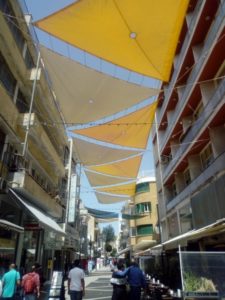
He is the most famous pedestrian street full of shops Nicosia, restaurants, cafes, offices etc.. The Ledra Street was named after the ancient city-kingdom of Cyprus, Ledra (7th c.) located on the site of the present city of Nicosia.
OCCUPIED NICOSIA - WHAT TO SEE
- PASSAGE IN OCCUPIED NICOSIA
The free area of Nicosia is divided by occupied with "Interpolated line of UN. in Cyprus"Or" Green Line "or"Dead zone», an area controlled by the UN. The "Green Line" was the 1963 and defined the boundaries of the Greek and Turkish Cypriots. The line took its name from the green marker used to define the boundaries on the map.
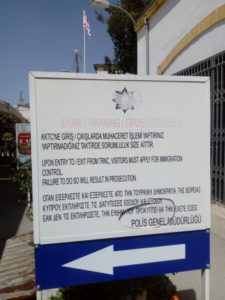
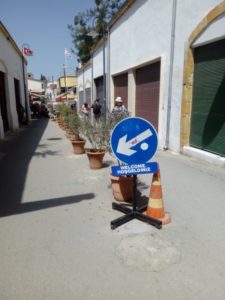
The passage to the Occupied Nicosia made from Ledras Street, the busiest street of the city. At the end of Ledra, there is an outpost of the Greek police, then the part of the "buffer zone" of the UN and after the Turkish police outpost. You have to show your ID or passport and two outposts. They will record your details and will pass in the occupied part of the city. If you buy something for which customs requires Greek police, when you sign, It will make you control. Once you pass the occupied side you will find a junction with benches and signs that indicate your directions.

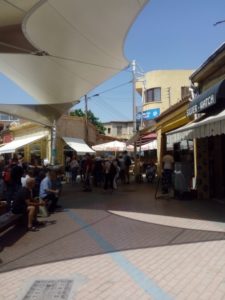
- BIG HANI
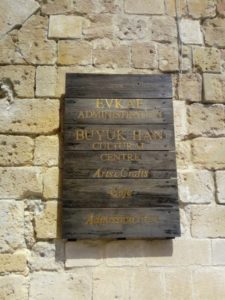
Το Great Khan, It is a rare example of Ottoman architecture. There inn "Hani" and facilitate trade, known as caravansarai, within the city. The British later used the site as a prison.
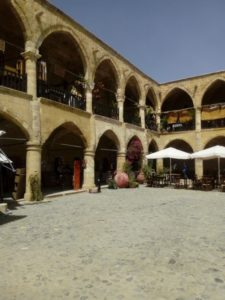
INTERNAL YARD
The Buyuk Han has two entrances, east and west. two floors, with 68 rooms facing an inner courtyard. today 10 from 68 They have been turned into souvenir shops. In the center of the courtyard is an octagonal mosque «masjid» resting on marble columns with a fountain at the bottom.
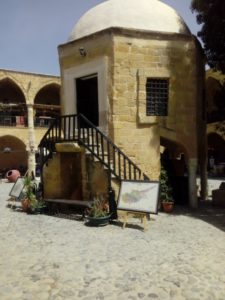
Cafés and restaurants, like Sedirhan Cafe (you can pay with Euros).
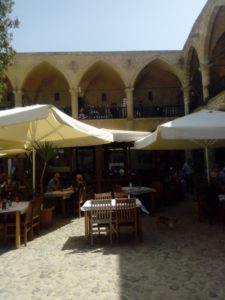
If you follow the sign pointing right, to Kunahricilaahri HANI and BIG HANI you will reach the square with the coffee- restaurant, Lorenza Coffee.
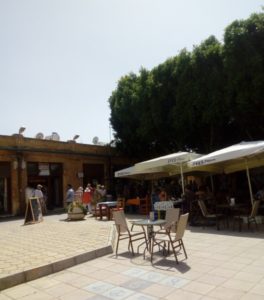
Opposite the small square you will see the high walls of BIG HANI and a sign indicating the entrance to this. Address : Arasta Sοkak
- Kunahricilaahri HANI
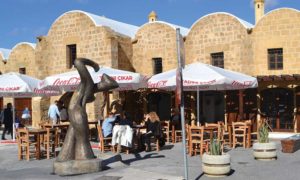
There inn, a caravansarai smaller than the Buyuk Han. It is a two storey building with rooms (originally 56) around an inner courtyard. The ground floor served as a warehouse and for animals and in 1The floor were rooms. Architectural has elements from the Venetian period and the Ottomans, with "Hani" elements. It has recently been renovated and you will find souvenir shops and cafe-restaurants. Address : AsmaaltI Street
- CATHEDRAL CHURCH OF HOLY WISDOM or S MOSQUETO ATTEND
The Cathedral of St. Sophia is one of the most important examples of gothic architecture in Cyprus, together with the Church of St. Nicholas Famagusta (Lala Mustafa Pasha Mosque). Construction began in 1209 and completed in 1326, when he dedicated to Hagia Sophia. It was severely damaged by earthquakes in 1491 and 1547. Here they became the coronation of kings of Cyprus, Lusignan (reigned from 1192 until 1489). THE House of Lusignan, They were a family of French nobility who were kings of Jerusalem, Cyprus and Armenia. THE Guy de Lusignan He was the founder Kingdom of Cyprus and the Caterina Cornaro It was the last queen of Cyprus (reigned from 1474 until 1489).
The 1570, when the Ottomans occupied Nicosia, They turned the church into a mosque, known as Glass Selimiye (Selimiye Mosque). They added within a «mihrab», i.e. a chime indicating Mecca and a lectern. At 15-5-1572, with the Sultan command Selim II minarets added, height 49 m. Having internal dimensions 66×21 m. and can hold 2500 faithful as it is the main mosque of the area. Address : Selimiye Street, after BUYUK HANI
- Turunçlu Fethiye Mosque or TURUNCLU MOSQUE
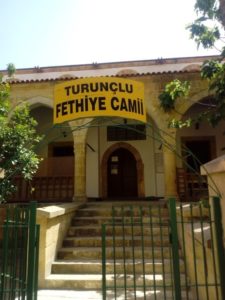
The Turunçlu Fethiye mosque It was built in 1825 Ottoman style and now serves as a place of worship. The minaret can be visited from the interior space. Address : Belik Pasha Street (left of the point where there are benches, on the opposite side of the BUYUK HANI).
useful information
- Cyprus is situated in If. Mediterranean and specifically BE. of Greece, N. Turkey, D. Lebanon and Syria, NW. Israel and B.. of Egypt.
- It's the 3The and most populous island of the Mediterranean
- The 1974 was the Turkish invasion of Cyprus by Turkey occupies today about 37% Island's, throughout the northern part of
- The 1983 It became Unilateral Declaration of Independence so called by the Turks "Northern Cyprus".
- The Republic of Cyprus controls 58% the area of the island
- about 5% the island is occupied by the UN(Green Line) and from the United Kingdom, which maintains the Akrotiri and Dhekelia
- Nicosia is the only European capital that is divided by the 1974, with the invasion of the Turks on the island
- 1-5-2004 the Republic of Cyprus or the Republic of Cyprus joined the European Union
- 1-1-2008 He joined the Eurozone and currency is the euro
- The official language of Cyprus to the EU. the Greek
Your tour of Old Nicosia can easily be done on foot or by bicycle. The Municipality of Nicosia has a bicycle rental program.
For Tomb of Makedonittissas and Central Prisons you can take a taxi or use the buses in Cyprus (www.cyprusbybus.com). The ticket is issued in bus, the driver, who can also guide you (one-way cost 1,5 €).
ACCESS IN CYPRUS
- Larnaka International Airport "Clerides'
Located 7 km from the center of Larnaca (tel. : +357 77 77 8833). From Greece you can get to this airport with direct flights (duration flight 1 time).
- Pafos International Airport
Located near Timi village and far from the center of Paphos 14 km. It serves mainly flights charters from European countries.







